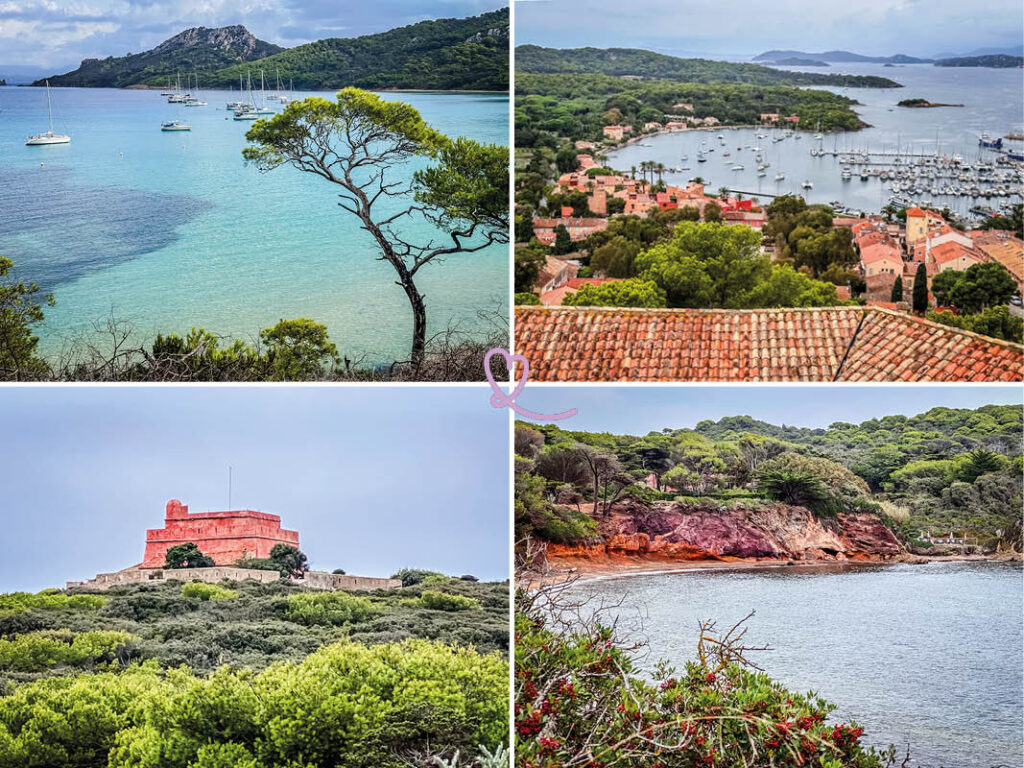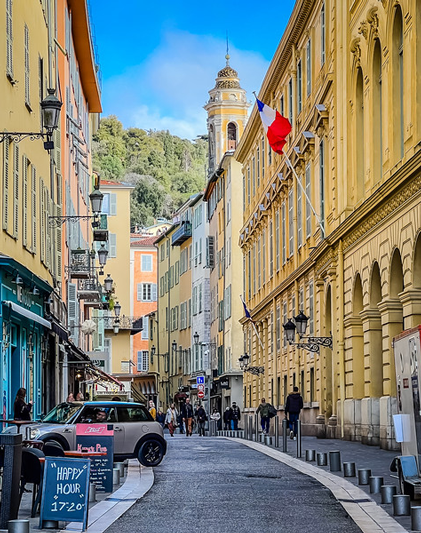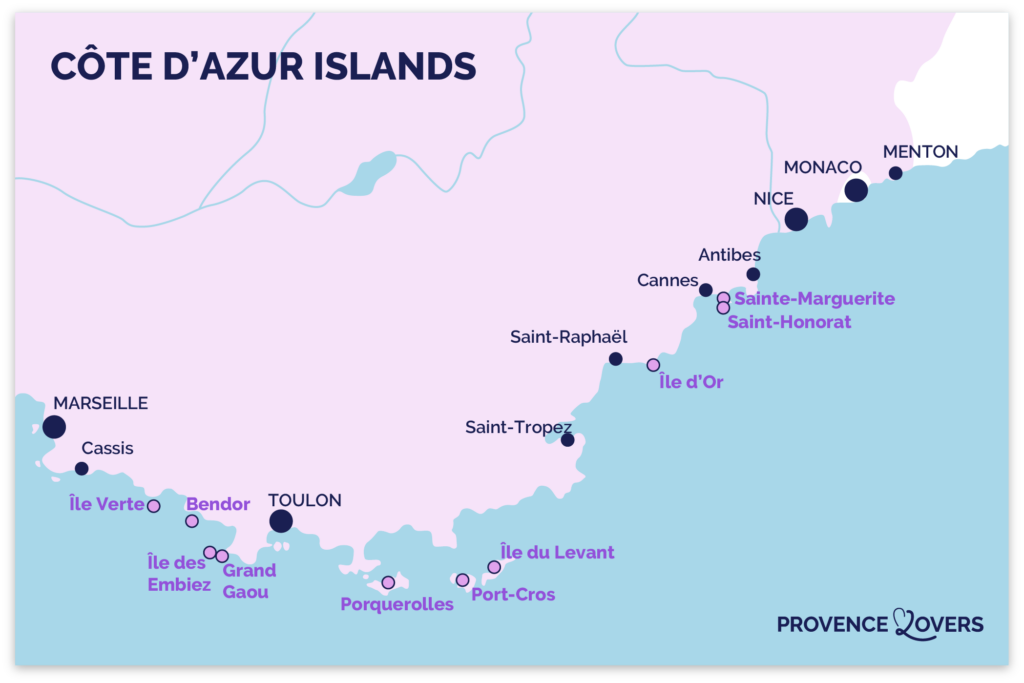Nestled in the heart of the Mediterranean, the island of Porquerolles is a true natural treasure. It attracts many visitors every year thanks to its crystal-clear beaches, hiking trails and unspoilt landscapes. Accessible by boat from Hyères, it is part of the Port-Cros National Park. The area offers an idyllic setting for a day or a weekend. Whether you want to explore its historic heritage , go cycling or just relax in the sun, Porquerolles is sure to please.
Here’s our guide to the must-see places on the Côte d’Azurisland of Porquerolles, and some useful tips for planning your visit.

This guide is completely independent, based on our experiences. We visited the region anonymously, making our own choices and paying our bills in full.
Is the island of Porquerolles worth a visit?
Absolutely! The island of Porquerolles is definitely worth a visit for its unspoilt nature, seascapes and rich heritage. We loved its sandy beaches and crystal-clear waters. Porquerolles offers an ideal setting for hiking and biking, thanks to a network of marked trails throughout the island. You’ll discover historic sites such as Fort Sainte-Agathe, a reminder of the island’s military past. We were charmed by the diversity of its panoramas, between pine forests, vineyards and secret coves accessible only on foot or by boat.
Porquerolles is one of the most beautiful islands on the Côte d’Azur!

1. Enjoy the crossing

We enjoyed the crossing between Hyères and Porquerolles, an experience that marks the entrance to a preserved island environment. From the Baie de la Tour Fondue in Hyères, the boat glides over turquoise waters, offering a first glimpse of the Mediterranean vegetation and idyllic beaches that line the island. Along the way, you can take in the sights and smells of the neighboring islands. We particularly appreciated the serenity of this short 15-minute crossing, ideal for observing the landscapes of the Côte d’Azur.

Arriving in Porquerolles, you’ll discover a welcoming harbor that leads directly to the village, creating a soothing contrast with the mainland. You’ll have plenty of time to enjoy the change of pace as the island gradually comes into view. We enjoyed taking the time to prepare ourselves for the discovery of this little corner of paradise.
- The crossing takes about 15 minutes from the Presqu’Île de Giens and about 1h15 from the Rade de Toulon.
- For more information on how to get to Porquerolles by boat, click here.
- You can also book a private excursion to discover Porquerolles off the beaten track, or on the occasion of a dinner cruise. for example!
A LITTLE MORE patience
All the photos, maps, information, good addresses to make your stay in Provence a success, will soon be gathered in a single ebook!
If you wish to be informed of the publication of our guide on Provence, subscribe:

2. Lazing on paradise beaches

We were charmed by the beaches of Porquerolles, true jewels of the Mediterranean. In fact, some of them are among the most beautiful beaches on the Côte d’Azur. Naturally, the island has several, each with its own unique character. Notre-Dame beach, on the east side of the island, is the best known. Often considered one of the most beautiful in Europe, with its fine sand and crystal-clear waters, it’s perfect for snorkeling.
To the north, the Courtade beach stretches for almost a kilometer, offering an ideal setting for swimming and water sports. The smaller, sheltered Plage d’Argent is appreciated for its calm and proximity to the village. To the south, the Grand Langoustier beach offers a wild and picturesque rocky backdrop.

The transparency of the water allows you to observe a rich and varied marine fauna while snorkeling. Some beaches are accessible to people with reduced mobility and equipped with showers and toilets (more info here). It’s important to note that the beaches of Porquerolles are part of the Port-Cros National Park, so we invite you to respect the rules of environmental preservation.
3. Immerse yourself in the history of Fort Sainte Agathe

We explored Fort Sainte Agathe, an emblematic Porquerolles building towering 40m above the island. Built in the 16th century on the orders of François I to protect the island from invasion, the fort has undergone several modifications over the centuries. Its current structure dates mainly from the 19th century, when it was remodeled to accommodate a larger garrison. The fort offers an exceptional panoramic view of the island, the Hyères harbor and neighboring islands.
Inside, you’ll discover a permanent exhibition on the natural, cultural and historical heritage of Porquerolles. You can also admire models, old maps and archaeological artefacts that trace the island’s evolution through the ages.

The fort also houses a collection of contemporary art, creating an interesting contrast between historical heritage and modern creation. The access road to the site is a well-maintained path. A visit to Fort Sainte Agathe provides an insight into the strategic importance of Porquerolles in the maritime history of the Mediterranean.
- The fort is open from Tuesday to Sunday between April 27 and November 3, from 10am to 1pm and from 3pm to 6pm. Guided tours are organized on Wednesdays and Fridays at 10 am.
- Price: €12 and €6 concessions.
- See the latest news on the official website, here.
OUR TPS FOR RENTING YOUR CAR IN Provence
- Compare prices on our preferred platform: DiscoverCars – one of the best rated sites.
- Choose a car that is powerful enough (the roads are steep) but compact (some passages are narrow).
- Think of thecomplete insurance (some roads are tortuous and narrow).
- There is a lot of demand, book it early.

4. Walk or bike the trails

We cycled the many trails of Porquerolles! An experience that allowed us to discover the diversity of the island’s landscapes. The more than 54km of signposted paths offer the opportunity to discover the island’s wild nature and historic relics, such as forts and military batteries. Trails wind through pine and oak forests, along steep cliffs, and lead to secluded coves. There are several paths around the island. We particularly enjoyed exploring them and taking in the panoramic views of the sea and nearby islands.

Cycling is a popular way to explore the island, but you can also walk! Porquerolles is an ideal playground for hikers and cyclists of all levels. You’ll easily find bike rentals in the village and plenty of facilities for parking your 2-wheeler all over the island. Please note that it is important to stay on the marked trails to preserve the island’s fragile environment.
5. Spend the night on Porquerolles Island

In our opinion, a stay on the island of Porquerolles is the best way to soak up its intimate atmosphere. The range of accommodation is limited, preserving its confidential and tranquil character, but requiring bookings to be made well in advance. The options are mainly concentrated around the village, with a few hotels and B&Bs to make the most of the island’s night-time calm. You’ll find human-scale establishments that emphasize local charm without extravagance. Book now your accommodation among the the best establishments on Porquerolles Island!

As night falls, the atmosphere changes, offering appreciable tranquility and clear starry skies, to be enjoyed from a terrace or while strolling around the village. Enjoy this timeless moment, when the island seems to belong only to those who spend the night there. By choosing to stay overnight, you’ll be able to discover a different face of Porquerolles, and enjoy it in the morning, before the day’s visitors arrive. Please note that bivouacs are forbidden.
WHERE TO STAY IN Toulon
Our favorites: neighborhoods and hotels
In the downtown area
Hotel Okko – see photos and availability
Hotel L’Eautel – see photos and availability
On the corniche
Hôtel Les Voiles – see photos and availability

6. Admire the Calanque de la Gorge du Loup

We took time to admire the calanque de la Gorge du Loup, one of Porquerolles’ natural treasures, nestled in a corner of the island’s south coast. This confidential spot reveals a cove with clear waters and unspoilt natural scenery. You can take a dip in the sea or simply observe the area from the heights, soaking up the calm of the surroundings.

The calanque is surrounded by cliffs and Mediterranean vegetation, creating a unique atmosphere where time seems suspended. It’s the perfect place to observe the wild beauty of Porquerolles, with its unspoilt coastline and natural colors. Don’t forget your mask and snorkel! It’s a perfect spot for snorkeling, where you can observe sea urchins and other small fish. Note that it’s difficult to descend into the calanque, as the path is very steep.
7. Visit the bastions

We explored the bastions of Porquerolles, military relics that bear witness to the area’s rich defensive past. These fortifications, with their thick walls and raised watchtowers, were built at different times and form a strategic network around the island. We were particularly interested in Fort de la Repentance, a buried defensive structure. You can discover the history of these fortifications through explanatory panels installed on the sites. The bastions offer exceptional views of the surrounding landscape. We were also surprised by the architectural diversity of these structures. It reflects the evolution of defense techniques over the centuries.

Some bastions have been restored and are now open to the public. A visit to the bastions reveals the strategic importance of Porquerolles in the defense of the French Mediterranean coastline.
- Only Fort Sainte Agathe is open to visitors in high season. Some of the other Bastions can be visited during the European Heritage Days (more info here).
- Click here to find out more about the Forts de l’Île de Porquerolles.
8. Explore the Langoustier peninsula

We headed for the Langoustier peninsula, a spit of land that stretches out at the western end of Porquerolles, offering contrasting, unspoilt landscapes. The path leading to the Pointe du Langoustier passes through a forest of Aleppo pines and holm oaks, creating a shady, fragrant atmosphere. During your exploration, you won’t want to miss the Fort du Grand Langoustier. Ochre in color, it dominates the island’s vegetation with its curious pyramidal silhouette reminiscent of an Inca monument. We were seduced by Plage du Langoustier, a stretch of fine sand bordered by turquoise waters, ideal for swimming and snorkeling.

As you explore the peninsula, you’ll enjoy exceptional panoramic views of the islands of Hyères and the Var coast. You’ll also see the Île du Petit Langoustier and its fort. Before you leave, keep your eyes peeled! You may come across an Ashen Shearwater. This seabird nests in colonies of several hundred individuals on the rocky islets and coastal cliffs of the Mediterranean islands. Click here to find out more about Presqu’île du Langoustier
9. Visit the Moulin du Bonheur

We visited the Moulin du Bonheur, an emblematic building standing proudly on the heights of Porquerolles. Built in the 18th century, this windmill was restored in 2007 by volunteers and enthusiasts, after 200 years of inactivity. Today, it is a precious testimony to the island’s agricultural heritage. Inside, you can discover the various parts of the mechanism, including the ancestral machinery that is still in working order. Explanatory panels explain the history and operation of the mill.

- The Moulin du Bonheur can only be visited as part of guided tours of Fort Sainte-Agathe: Wednesdays and Fridays at 10 a.m. between April 27 and November 3.
- Price: €12 and €6 concessions.
- See the latest news on the official website, here.
HAVE FUN WITH THESE activities
- Great kayak trips in:
Saint-Tropez to the Ramatuelle reserve
Cassis to the calanques - Helicopter flight from Cannes
- Shuttle service along the coast between Nice and Saint-Tropez
- Bike tours: eBike in Nice – Mountain biking in the Esterel massif

10. Stroll through the village streets and discover the treasures of Sainte-Anne Church

We strolled through the picturesque streets of the village of Porquerolles, the beating heart of the island and the starting point for all our explorations. With its rosy-faced houses and shady squares, we found it very charming. The Place d’Armes, the town’s nerve center, hosts a lively market in season. We were won over by the friendly atmosphere in the cafés and restaurants, where locals and visitors rub shoulders. We enjoyed strolling along the harbor, admiring the colorful boats.

Sainte-Anne Church, built in 1850, is a must-see in the village. Inside, you can admire a unique Stations of the Cross, carved by knife from solid walnut in 1869 by Joseph Wargnier, a convalescing soldier. Encouraged by Father Ollivier, the island’s chaplain, he completed each of the 14 stations. After his recovery, he deserted, but escaped punishment thanks to the priest’s intervention. This treasure has been listed as a Monument Historique since 2019.
Finally, if you’re interested, the Maison du Parc National de Port-Cros, located near the port, offers invaluable information on the island’s flora and fauna.
- Sainte-Anne Church is open all year round from 8am to 5pm, and until 7pm in summer.
- Access is free of charge.
Subscribe to our Newsletter
- Get away from it all with Region Lovers’ beautiful destinations!
- Once a month
- Advertising-free
Other attractions in Porquerolles
Discover the island from the sea on a boat trip

There are a number of boat excursions to the island of Porquerolles, with its secluded coves, cliffs and secret beaches. Here are our favorite excursions:
- Catamaran dinner cruise around Hyères – Find out more and book
- Speedboat excursion and treasure hunt to discover the island – Find out more and book
- Half-day cruise along the Porquerolles coast with aperitif – Find out more and book
- Day trip to Porquerolles including private boat trip , visit to the Fondation Carmignac, wine tasting and lunch – find out more and book
The botanical conservatory

The Conservatoire Botanique de Porquerolles, a site dedicated to the preservation of Mediterranean plant species. It protects and promotes a diversity of local and rare plants, while raising public awareness of the importance of biodiversity. Walking along the paths, you can observe ancient fruit trees, traditional vines and rare plants, all cultivated using techniques adapted to island conditions. The site embodies Porquerolles’ historic link with agriculture, highlighting typical local species such as olive and fig trees. Find out more here.
The Carmignac Foundation
The Fondation Carmignac is a unique place in Porquerolles, where contemporary art meets Mediterranean nature. Nestled in a villa in the heart of the island, the foundation exhibits a rich collection of works, ranging from paintings to sculptures and photography, presented in an architectural setting open to the vegetation. We recommend a visit to the Fondation Carmignac, for an original approach to art exhibitions. Find out more here.
Book your day at Porquerolles including a private boat trip , a visit to the Fondation Carmignac, a wine tasting and lunch – find out more and book
How to get to Porquerolles Island
Where is Porquerolles?
- In the Var region
- Hyères to Porquerolles = 15min by boat
- Toulon to Porquerolles = 1h15 by boat
Here’s a map of the French Riviera islands to help you locate Porquerolles:

How to get there?
To reach the island of Porquerolles, the main departure point is the Tour Fondue pier, located in Hyères, Var.
- By car, you can reach the Tour Fondue from the center of Hyères in about 20 minutes. In high season, it is advisable to allow extra time due to the crowds.
- If you’re arriving by train, the nearest station is Hyères, with links to the main towns in the region.
- Bus no. 67 runs from Hyères to the Tour Fondue. Route map and timetable, here.
Once at Tour Fondue, ferries run to Porquerolles throughout the day, with frequent departures in high season. The return fare is €24 per adult. Find out more here.
You can also join the island by private boat for an unforgettable day exploring Porquerolles and its hidden coves.

Parking
Near the Tour Fondue pier, 3 parking lots are available: Parking des Îles, Parking TPM and Parking Porquerolles.
Prices range from €10 to €15 for a day (10 hours), and up to €18 for 24 hours. Some parking lots offer the option of reserving a space in advance. In summer, we strongly recommend arriving early (before 9 a.m.) or reserving your spot to guarantee parking. Find out more here.

Useful tips for visiting Porquerolles Island
How long and when?
To get the most out of Porquerolles Island, a full day is recommended. This time will allow you to discover several beaches, hike or bike trails, and explore cultural sites such as Fort Sainte-Agathe or the Carmignac Foundation. If you’d like to explore further or take boat trips around the island, a 2-3 day stay may be ideal. In fact, we think Porquerolles is an ideal destination for a romantic or unusual weekend!

Spring and autumn are the best times to visit, with pleasant temperatures and moderate visitor numbers. Summer is a popular time of year, especially for enjoying some of the most beautiful beaches on the Côte d’Azur. The island can therefore be very busy in July and August. To avoid the crowds, it’s best to arrive early in the morning, especially in high season, or to favor the months before and after the season for a quieter atmosphere.
Tour directions, map and difficulty

Of course, there’s no fixed route, but we recommend you start in the village, where you can rent bikes and where most of the trails start. This will enable you to orientate yourself quickly and explore the different paths from a central point. The network of well-marked trails offers many options, from the seaside to wooded inland areas. If you’re planning a walk, you’ll find that most of the routes are accessible without any particular difficulty, with flat or gently undulating terrain.

However, some coastal paths can be more damaged, requiring greater attention. A map is available from the tourist office, and can help you locate major points of interest and plan your route according to the time you have available. This allows you to adapt your visit to your own pace, according to your preferences and the weather conditions.
Restaurants
We haven’t tested the Porquerolles restaurants yet. Also on our list: Restaurant L’Orangeraie, Restaurant L’Escale, Restaurant de l’Hôtel la Villa Sainte Anne and Le Pélagos.

PLAN YOUR TRIP TO THE Côte d’Azur
- Inspiration
The most beautiful landscapes in 30 photos
Best things to do on the Côte d’Azur
Most beautiful villages
Best beaches on the Côte d’Azur
Most beautiful gardens
Best boat tours (coming soon)
Most beautiful islands
Secret places

- Practical advice
Successful travel on the Côte d’Azur (coming soon)
Rent a car in Provence – in Nice – in Cannes – in Marseille – in Aix-en-Provence.
Itineraries: 5 days – 1 week – 10 days
Weekend ideas: best-of – romantic – luxury – unusual

- Where to stay
Where to stay on the Côte d’Azur
Best luxury hotels on the Côte d’Azur
Hotels by the sea
Best boutique-hotels






